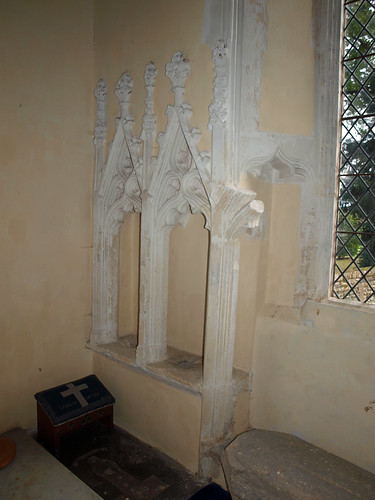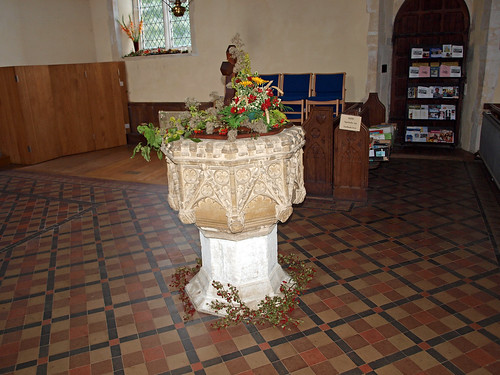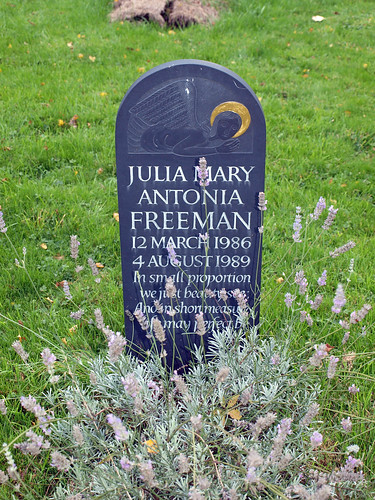ST MARY. Nave and chancel and W tower. All Dec except for the Perp tower. Wide nave and chancel. Tall two-light windows. Only the E window is bigger - a good piece of five lights with flowing tracery. Double Piscina with ogee arches and steep gable. The Sedilia which were set against the window are mostly broken off. Dec N porch with two-light windows. Niche over the entrance. Battlements with flushwork chequerboard decoration. - FONT. Octagonal. Early C14. Simple arches under gables, much use made of the encircled quatrefoil. Embattled top. No ogees. - BENCHES. A few in the chancel. - STAINED GLASS. Fragments in several window-heads. - PLATE. Cup 1624; Paten c. 1710; Almsdish 1765.
BUXHALL. God’s house here is nearly all of it 600 years old and stands prettily by the parsonage at the back of a meadow. Big and lofty it is, with a fine massive tower whose buttresses are patterned with squares of flint and stone. It has a mass dial. The east window is striking for its flowing tracery, and the west window is even better, for in it are four delightful panels of 14th century glass showing yellow figures on red backgrounds. We see two golden-winged angels, a saint seated, and Christ with His hand raised in blessing. Just as old, and fine too, is the font, decked out with battlements and buttresses and pinnacles and tracery round its sides. There is a piscina with two elaborate canopies, an old coffin-lid with a floral cross, and a pair of old panelled benches carved on the front with tracery, their poppyheads fashioned into heads of strange animals and curly-haired boys.
Buxhall has had its Dick Whittington, for here was born in 1512 Sir William Coppinger, who became Lord Mayor of London. Half his estate he left to the poor, and half to his relations, whose hospitality was such that “to live like the Coppingers” became something of a byword. It was to one of them, Walter Coppinger, that Henry the Eighth in 1512 gave permission to wear his hat in the royal presence. The document concerning this privilege, which is now in the safe keeping of the British Museum, quaintly puts it in these words:
We be credibly informed that our trusty and well-beloved subject Walter Coppinger is so diseased in his head that without his great danger he cannot be conveniently discovered of the same: In consideration thereof we have by these presents licensed him to use and wear his bonet upon his said head as well in our presence as elsewhere. Henry R.
Buxhall has had its Dick Whittington, for here was born in 1512 Sir William Coppinger, who became Lord Mayor of London. Half his estate he left to the poor, and half to his relations, whose hospitality was such that “to live like the Coppingers” became something of a byword. It was to one of them, Walter Coppinger, that Henry the Eighth in 1512 gave permission to wear his hat in the royal presence. The document concerning this privilege, which is now in the safe keeping of the British Museum, quaintly puts it in these words:
We be credibly informed that our trusty and well-beloved subject Walter Coppinger is so diseased in his head that without his great danger he cannot be conveniently discovered of the same: In consideration thereof we have by these presents licensed him to use and wear his bonet upon his said head as well in our presence as elsewhere. Henry R.



No comments:
Post a Comment